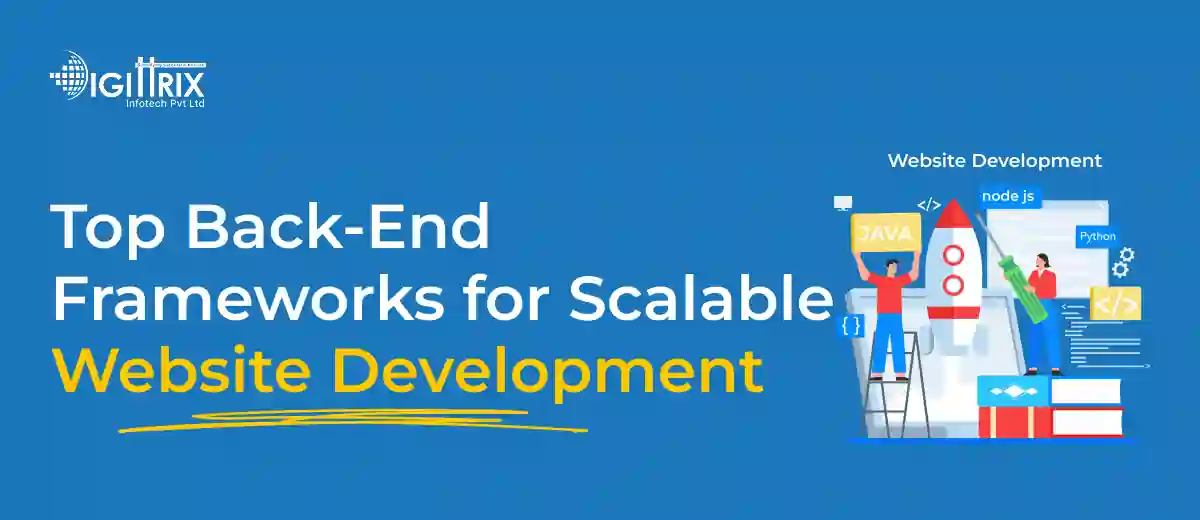Selecting a strong back-end framework plays a key role in performance, scalability, speed, and secure data handling for modern and growing online platforms.
Highlights
With Over 14 years of Experience in the IT Field, Helping Companies Optimise there Products for more Conversions

Creating a website that performs well, even as the number of users grows, requires solid planning and smart technology choices. One of the most important parts of this process is selecting the right back-end framework. A good back-end framework allows developers to build websites that handle traffic efficiently, respond quickly, and work smoothly under pressure.
In this article, we will take a close look at the best back-end frameworks used today for building scalable websites. These tools are popular among developers because they offer structure, flexibility, and the necessary tools to build powerful web applications. Whether you are working on custom website development or seeking options from a web development company, understanding these frameworks is essential.
Worried about your website’s safety? Learn the key website security measures every online business should implement to stay protected.
Before we go further, let’s understand what a back-end framework is. A back-end framework provides a base or structure for developers to build server-side applications. It helps manage the database, server, and business logic of a website. In simple words, it controls how data is stored, processed, and sent to the user interface (or front-end).
Good back-end frameworks save time and reduce the chance of bugs by offering ready-to-use tools, features, and methods. They also help maintain clear coding standards across projects.
Scalability means your website can grow. It can serve more users, manage more data, and handle more tasks without slowing down. Choosing a framework that supports scalability allows developers to build websites that continue to work well as demand increases.
Not every framework is designed to handle growth. Some work well for small projects but struggle when traffic spikes. That’s why developers and businesses offering web development services often focus on proven frameworks that are known to handle heavy loads and larger user bases.
Node.js is designed for high performance and can handle multiple requests simultaneously. This makes it a great choice for websites that expect a lot of traffic or real-time activity, such as messaging apps or streaming platforms.
Many developers choose Node.js when they want to stick with one programming language across the entire project. It also has a large community, which means strong support and frequent updates.
Although small in size, Express is highly flexible. Developers can build large-scale applications by adding components as needed. It gives full control over how routes, middleware, and logic are handled.
Businesses looking for custom website development often choose Express.js for its speed and ability to grow with their needs.
Django follows the “Don’t Repeat Yourself” (DRY) principle and encourages clean, maintainable code. It can support complex applications and integrates easily with various database systems. Websites like Instagram and Pinterest have used Django to manage millions of users.
When using web development services, Django is often recommended for businesses needing strong data handling, fast development, and long-term project support.
Laravel supports caching, session management, and database operations efficiently. Its queue system allows tasks to be delayed and processed in the background, which improves performance during high traffic.
Laravel also has Laravel Horizon and Laravel Vapour, tools designed to manage queues and serverless deployments. These features make it easier to scale apps based on traffic and data demands.
Rails applications can be optimized with background jobs, caching, and cloud hosting. It works well for startups and medium-sized applications. However, with proper optimization, it can also support large-scale platforms.
Web development companies often use Ruby on Rails for MVPs (Minimum Viable Products) that may later grow into larger services.
Spring Boot applications can be broken down into microservices. This means different parts of your application can run independently and be scaled separately. It’s ideal for companies needing stable, secure, and large-scale web platforms.
Spring Boot is often a go-to option for companies offering web development services to industries like banking, health, or e-commerce.
ASP.NET Core is designed for performance. It can handle large numbers of requests and has a modular system. It is used by many large organizations for building enterprise-level applications.
This framework is often used by a web development company that works with Microsoft technologies or enterprise-grade clients.
Flask is often used as a base for microservices. This makes it a solid choice for developers who want complete control over how the app is structured. Though it’s lightweight, Flask can handle heavy loads with proper planning.
Businesses investing in custom website development often choose Flask when they need flexibility and speed for smaller applications that might grow later.
There’s no single answer for which framework is the best. The right choice depends on:
Working with a professional web development company can help you pick the most suitable option for your project goals.
Wondering why growing businesses opt for custom web development? Discover top‑rated reasons why customization fuels growth in the digital era.
The back-end framework you choose lays the foundation for your website's performance and growth. Some frameworks offer speed and flexibility, while others provide structure and advanced features for managing large applications. Each one mentioned above has its strengths and is used by thousands of developers around the world.
When planning custom website development, it is important to consider future scalability. A website that works well today should continue to serve its users tomorrow as their numbers grow. That’s why making the right decision early can save time, effort, and cost down the road.
With the help of professional web development services, you can make the best use of these frameworks to build websites that are strong, responsive, and ready for growth.
Build strong, high-performance websites using some of the most trusted back-end frameworks in the industry. At Digittrix, we assist businesses in creating scalable and secure web applications by choosing the best tools for each project’s needs. Whether it's Node.js, Django, Laravel, or ASP.NET Core, we guide you through the most suitable technologies that support long-term growth and performance.
Thinking of starting your custom website project? Partner with Digittrix a website development company with over 14 years of experience in professional web development. Our skilled team provides tailored web development services based on reliable frameworks, ensuring functionality, stability, and efficiency.
If you're planning to develop a scalable web application and aren’t sure where to start, book a consultation with our experienced technical managers. Call us at +91 8727000867 or send your questions to digittrix@gmail.com.
Let Digittrix help you build a powerful, scalable website from the ground up.

Do you need help in Web Development ?




Join over 1500+ businesses we've already helped!
A back-end framework is a set of tools used for building the server-side logic of a web application, such as managing data, requests, and server tasks.
A good scalable framework effectively handles many users, supports large databases, and maintains steady performance under high traffic or data loads.
Yes, certain frameworks are more appropriate for complex applications because of their structure, performance, and built-in features.
Some frameworks are flexible enough to support both small and large projects, although some tools may be better suited for large-scale solutions.
Using a single language can simplify development, but many modern projects employ multiple languages depending on the application’s requirements and architecture.

©2025Digittrix Infotech Private Limited , All rights reserved.